fall08

INSIDE THIS ISSUE:
 |
Photo by Joe Nelson, June 22, 2008 |
Tunbridge, Vt., June 22, 2008 - The Vermont Historical Society's ninth annual exposition closed today, successful in spite of two days of mixed hot and rainy weather.
The Vermont Covered Bridge Society has participated in the Vermont Historical Society's annual two-day expositions since the first one, which was held in the year 2000, all at the Tunbridge Fair Grounds. Life Member Irene Barna has organized the VCBS booth for each of them.
This year the booth was located near the doorway in the Memorial Arena, not far from the Grand Stand, consequently we had a good flow of people interested in covered bridges.
Over the two days, June 21 and 22, our booth-sitters answered hundreds of questions. The most frequent question—"Why are covered bridges covered?" Some folks had amazing theories of their own.
Our booth featured drawings and photos of covered bridges, covered bridge trusses, and a large state map showing the covered bridge locations. Also prominently featured was the digital projector donated to the VCBS by Neil and Suzanne Daniels. The projector displayed 101 of Vermont's covered bridges in full color on a large screen.
Our thanks go to Neil Daniels, who constructed the booth, and Joe Nelson, who assisted him on set-up day, and acted as booth sitters on the show-days. Many thanks are due to booth sitters John Weaver, David and Marikka Guay, Irene Barna, Suzanne Daniels, and Ruth Nelson.
by Amy Ash Nixon, Caledonian Record Staff Writer
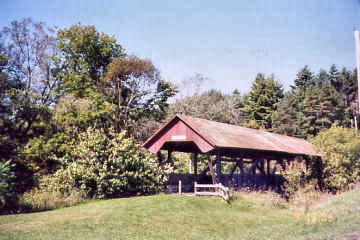 |
Photo by Liz Keating, Sept. 19, 2005 |
This week, Lyndon selectmen gave Municipal Administrator Dan Hill the OK to enter into a contract for the design phase of engineering with the firm of Dubois & King for up to $32,000.
Of that amount, Hill said, $25,000 will be covered by a state grant and $5,000 by the town's historical society, which has pledged a gift in that amount.
The town had budgeted $2,000 toward the project, but the contract that came in from Dubois & King was for slightly more - after they had scaled back the initial scope to drop the price, Hill said. The final proposed amount proposed is $33,160, and with selectmen approving up to $32,000, the project is $1,160 more than what the town had budgeted.
Hill, along with the historical society, are in discussions with the Lyndon Area Chamber of Commerce, which actually owns the historic covered bridge, to see if they can help with the shortfall of slightly more than $1,000.
Chamber President Donna Wheeler said Thursday the chamber is discussing the issue now with the town and Dick Boera of the historical society, and no decision has been made on the chamber's role in helping with the cost of the design work.
The bridge, no longer in use, came to be owned by the chamber in a three-way agreement between the town, the chamber and the Burringtons in 1965. The town didn't realize the chamber owned the bridge until just a few years ago, when a copy of the agreement surfaced.
The subject of the bridge came up at the chamber's recent meeting. Chamber members decided to revisit the issue at a future meeting to determine the best course of action.
"We are also hoping that the town might be able to come up with some additional financing and the chamber - as its owners - might see its way clear to contribute a small sum also to help 'bridge' the gap," Boera wrote to the chamber in a recent letter.
The historical society requested chamber permission, the article in the May chamber newsletter states, to proceed with work on the bridge, without necessarily committing any funds.
At Tuesday's meeting, Hill said the cost of the design work for the bridge has been cut back due to budget
Jeffrey W. Tucker, president of Dubois & King, the firm who will do the Randall Bridge project for the town, said more tweaks to the scope of the work will be made to get it to $32,000.
The plans for the work call for a study of the required repairs of the bridge itself. The scope of the project, as proposed, calls for developing existing condition information regarding the structural members of the bridge, conducting a load rating analysis to quantify their capacity, and to evaluate repairs to stabilize the bridge and to present recommendations for improvements."
The firm will meet with town and historical society officials, the project plans state, to "gain insight on the goals project, including funding sources, repair/rehabilitation goals and expectations," to implement the improvement plans following the study and planning part of the project which is what the funding to date will cover.
[Our thanks to Amy Nixon for her permission to reprint this article which first appeared in the Caledonian Record of St. Johnsbury, Vt. Our thanks to Marge Converse for alerting us – Ed.]
by Joe Nelson
From the discussions, Ellen lists technical considerations to include the length of the video, its content (all 100 bridges or divide the project into geographical areas), time spent on each bridge, the content of information about each bridge, guest speaker and narrator, time of year, budget, and graphics.
The two largest problems to be solved for the project to proceed are funding and people. The project needs grants for funding, people to find the grants, win them, and manage them, and people to assist in the production in various ways.
A committee needs to be formed to support the project by addressing its needs, solving its problems and, finally, go before the VCBS Board of Directors to argue for the approval of the Video Project.
Anyone who would like to work on the Video Project in any capacity please contact Joe Nelson at jcnelson@together.net or write: Joe Nelson, P.O. Box 267, Jericho, VT 05465.
BRIDGE SOCIETY, MIDDLEBURY, April 19, 2008
President John Weaver called the meeting to order at the Ilsley Public Library in Middlebury on April 19, 2008 at 10:10. Fifteen people gathered on a spectacularly beautiful, warm morning.
SECRETARY'S MINUTES: The meeting was begun with a reading of the minutes of the, October 13th, 2008, fall meeting held in Northfield, VT by Secretary Irene Barna. No additions or corrections brought forth, the minutes were accepted as read.
Treasurer's Report: In the absence of the treasurer, there was no treasurer's report.
COMMITTEE REPORTS:
Membership: Membership stands at 149: 24 of which are in arrears, 11 are paid-up through 2009, and 55 are Life members, Honorary-Life, or Couple Life.
Trish Kane, in a report of January 2008, states that of 155 members, only 73 are Vermonters whereas there are members in 22 states and Canada.
Communications Committee: A revised edition of the Handbook is available in both hard copy and in PDF format. Joe Nelson has acquired a power point capability and is revising the VCBS slide show to digital power point. The slide show has been created for ILEAD (Institute for Life-long Learning at Dartmouth.
Historical Committee: Chair Joe Nelson reports that the name of the Crafts Standing Committee has been changed to the Historical Committee.
The activities of the Crafts Committee will continue as part of the Historical Committee. The current chair mentions that the committee is in need of a permanent chair and asked if someone would volunteer to fill this vacant position.
The cache of books donated to the VCBS has been handed over to Librarian/Archivist Warren Tripp who will organize the lending library. A listing of the books is available on request. Three volunteers had stepped forward and Warren was voted the job. Among various reasons why Warren was the best choice was mainly the access to the books to make them fully accessible to the membership.
The collection of bridge articles, news clippings, post cards, etc. is being organized by Rae Laitres.
A stash of prints of Eric Tobin's painting of the Cambridge Junction Covered Bridge has been renewed by Terry Shaw, owner of the Visions of Vermont Art Gallery in Jeffersonville. The original painting is available for sale at $2400.
Events Committee: Johnny Esau mentions the upcoming Vermont History Expo June 21 and 22 in Tunbridge, VT. The VCBS will, again, have a booth and he encouraged sign-ups for booth staffing as well as for set-up and tear-down
The 9th Annual Fall VCBS meeting will be held October 11, 2008. Much discussion was had regarding a site; but no final decision was reached.
The third weekend in April and the second weekend in October have been set as committed meeting dates for the VCBS annual spring and fall meetings. These times were firmed so that there was predictability in meeting dates and members could plan ahead.
Bridge Watch: Jack Tesse has sent photos and reports of Thetford area bridge upgrades. John Weaver says, "Sayers bridge looks nice from the photo."
The Shoreham Railroad bridge work is done. Many large stones had been placed to deter ATVs and snowmobiles from accessing the bridge; but reports are that they have not been successful as many tracks of such vehicles were evident.
John Weaver mentions that the bridge is owned by Historic Preservation and the site is owned by Vermont Fish and Wildlife who are both not likely to be happy about this vehicles use.
Swamp Road (Cornwall-Salisbury) Covered Bridge is currently inaccessible because of spring flooding. Rehabilitation construction will resume when access is available.
The Creamery Bridge in Brattleboro work should be done in early 2008.
The School House bridge in Troy will be finished spring 2008. The fire retardant coatings were yet to be applied. Trusses were re-cambered and straightened and foundations renovated. The laminated deck was also replaced.
Braley is to be done by the end of June and back in place. There has been a temporary bridge at the site.
Joe Nelson mentions the drawing at $1.00 per ticket.
Legislative Watch: No report presented; but it was mentioned that because of State budgetary constraints; the single project of signage for Covered Bridges has lost it's priority standing.
OLD BUSINESS: The lilac bush in memory of John Dostal to be planted in the Garden at the Bennington Center for the Arts is still an item pending on the return to the east coast of Bruce Laumeister. Inasmuch as the garden was still under construction and the bush would be shipped bare-root; it was decided to wait until the fall to ship so that it could be immediately planted upon arrival--pending on the readiness of the garden site.
Johnny Esau is the contact person with the Bennington Center for the Arts on this matter.
NEW BUSINESS: David Guay, member from New York State, mentions a new covered bridge in Putman County in southeastern New York. The bridge is not far from Danbury, CT at the Headquarters of the Hudson Valley Land Trust in the former Patterson Town Hall. It appears, from photographs, that it is a five-panel Long Truss. Question was raised whether the bridge actually is a Long Truss or a stringer since it is difficult to determine from the photographs.
Irene Barna mentions that a recent e-mail from a representative of the Theodore Burr Covered Bridge Society suggests that the Pennsylvania society is pursuing punishment for persons desecrating historic structures. Legislation needs to be in place to more severely punish perpetrators as community service seems to be the only punishment at this time. Nothing is pending in New York State to David Guay's knowledge.
The status of the Hammond Covered Bridge in Pittsford, VT was mentioned to which John Weaver stated since that stabilization, nothing more is currently planned. The Town of Pittsford deeded the bridge to the Division of Historic Preservation prior to the beginning of the stabilization work. Apparently that deeding had actually never been completed. The bridge has been open to pedestrian-only traffic since the stabilization.
Trish Kane reports in an email that the Covered Bridge Resource Center in New York State is seeking monetary donations. The Center is part of a library; but has a room set aside for the covered bridge library. David Guay motioned that the VCBS send $100 in support of the Center. His motion was seconded by Johnny Esau, but was later amended that the final decision rest in the hands of the VCBS Board of Directors for the availability of the funds. That amended motion carried.
Irene Barna mentions that the Pulp Mill Bridge in Middlebury/Weybridge underwent some very heavy traffic demand recently when a small fire in a building almost adjacent to the Battell Bridge in downtown Middlebury closed all traffic through downtown. The Pulp Mill Bridge is the only other crossing of the Otter Creek in Middlebury for many miles, both upstream and downstream.
A joint Middlebury/Weybridge Selectboard meeting on a Monday relating to the Pulp Mill rehabilitation (attended by an engineer presenting the Hoyle-Tanner; John Weaver, representing VTrans; Jan Lewandoski, who has done much of the recent rehabilitation of the bridge; Joe Nelson; and Irene Barna) followed by the fire on Tuesday, permitted the Thursday edition of the Addison Independent newspaper to carry photographs and an editorial regarding the incident and the critical piece the covered bridge plays in the transportation infrastructure of the area.
Thank you to Johnny Esau for arranging for the pizza lunch.
PRESENTATION by Ed Barna
The presentation was a synopsis of the presentations Ed has given for the past few years as a member of the Vermont Council on the Humanities Speaker Bureau.
Respectfully submitted, Irene Barna, Secretary
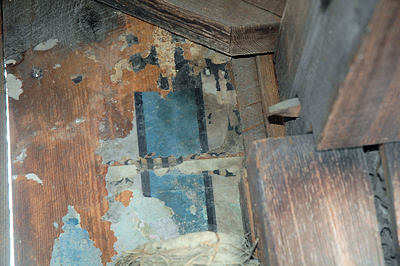 |
What posters were pasted on the inside of the west gable siding of the East Fairfield Covered Bridge? Unless a long-time resident of the village will tell us we may never know.
In the course of the reconstruction of the old bridge the siding was removed, stacked, and taken away, the ancient paste-ups with it.
Subsequently, VCBS Life Member Rae Laitres and her husband Richard sorted through the lumber stack at contractor Blow and Cote's storage building. They found one board with part of the paste-up still adhering. Ms. Laitres is putting her find in a safe place.
Asked why she went to so much trouble, Rae replied; "I love covered bridges and I love history. I couldn't let this piece of history to just disappear."
Also in the bridge were siding stringers with old ad stencils in black paint, and Spavin Cure posters tacked to tie-beams. These were preserved on film by Rae and by Joe Nelson. The most intact Spavin Cure posters were carefully taken down by Nathan Cote and given into the custody of the VCBS for preservation. Our thanks to Nathan.
by Joe Nelson
August 23, 2008 - Congratulations, Ashtabula, Ohio, now home to the Nations Longest covered bridge. The new bridge is a milestone in highway bridge technology in that is constructed of wood instead of steel or concrete. Given the longevity of 100-years plus of timber bridges in Vermont, Ohio, Indiana, and elsewhere, it was long past time for the engineering community to have taken advantage of the properties of wood. Let them study this new bridge and learn from it.
However, I just read an article about the new bridge published by the Cleveland Plain Dealer on http://blog.cleveland.com/metro/2008/08/ashtabula_county_covered_bridg.html that has to be answered.
In spite of being given the facts about the Cornish-Windsor bridge, the intrepid reporter wrote:
"The Cornish-Windsor Bridge over the Connecticut River can no longer claim the title as America's longest covered bridge. The historic structure, built in 1866, runs a measly 449½ feet while connecting Cornish, N.H., to Windsor, Vt., according to the state."
Actually, Mr. reporter, it's a "measly" 460 feet long, long enough to cross the Connecticut River at this place. It was built in 1866 by James F. Tasker and Bela J. Fletcher, two good New Hampshire bridge-wrights using 19th-century technology and the rules and skills of expert carpenters (no computers and engineering software), and without engineering degrees.
The Cornish-Windsor bridge was built by hand (no power tools), and erected without a regiment of cranes to lift timber and stone into their places. It was built on a single pier for a reason: the Connecticut River doesn't tolerate piers—it builds dams against them out of ice, trees, and houses and destroys the bridge. Three bridges built on this site were all destroyed by the Connecticut River. Not this one—our guys designed the bridge using a timber version of Ithiel Town's lattice truss capable of the longest single span yet attempted in those times.
The one pier supports two bridges, each 230 feet long (divide 460 by 2). The Ashtabula bridge, 613 feet long, is supported on 3 piers, that is four bridges, averaging roughly 204 feet in length. The Windsor-Cornish remains the longest two-span covered bridge in the United States, which, according to New Hamphire's historic site marker, is all that it claims to be. Next time, please Mr. reporter, get it right.
 |
Question Number 8 - I have always felt the best way to pay tribute to someone is to ask the folks who really knew them. With that in mind, I think our readers would enjoy your responses to the following questions/comments regarding Rick.
1. Did you ever meet Rick in person, (if so, when, where and what was the occasion(s). What was your impression of him and how did he influence you in regards to covered bridges?
2. As you know, Rick also wrote many books on covered bridges. How did his books influence you in regards to our bridges?
Joseph Conwill, ME - My first contact with Richard Sanders Allen was through his books, but I briefly saw him at the Second New England Covered Bridge Festival in Rutland, August 1968. We began corresponding about that time, and I think we met in person three times afterwards. We were living in different parts of the country, so most of the contact was by letter.
Rick was always one of my greatest heroes. What he did is extremely difficult—becoming the premier authority in his chosen field of covered bridges (and a major authority in several other historical fields too), without having any formal academic or institutional connection. Everyone respected him and relied upon his historical judgment. Most of the structure by which we understand covered bridge history was laid out by him; his ideas and even his language are echoed in nearly all subsequent writers. What Edward Gibbon is to the history of the Roman Empire, so is Rick Allen to the history of covered bridges.
Ben & June Evans - We never had the pleasure of meeting Rick Allen in person; however, he very graciously contacted us to compliment us after purchasing one of our guide books on covered bridges.
His books, several of which are in our library, were an invaluable source of information in the preparation of the above mentioned book as well as any of our other covered bridge writings.
Bob & Trish Kane, NY - Bob and I never had the pleasure of meeting Rick Allen in person, but we sure felt like we knew him well through our correspondence. We also spoke with him several times by phone. He was wonderful about answering our many questions and he always thanked us for keeping him up to date on covered bridge news, especially from New York State.
He was also very encouraging and complimentary about our covered bridge work. His message on his 2006 Christmas card was especially inspirational and heart warming to us. He wrote, "Dear Trish and Bob, You and Bob have my nomination as: Dedicated people who have done the most for authentic covered bridges in 2006 (and probably 2005 and 2007). Happy Holidays! Rick". Although we never met him in person, his continued support, encouragement and praise made our covered bridge research even more enjoyable.
Our Covered Bridge Library includes each of his books and they are a constant means of resource for us. He was truly a great man and his passing is a tremendous loss to the covered bridge community. His legacy will certainly live on for a very long time.
Miriam Wood, OH - While I never met Rick Allen in person, I felt that I knew him because he was always so courteous and helpful in answering my many questions. As I was working on my first book, The Covered Bridges of Ohio, an Atlas & History in 1993, Rick sent me information from an old newspaper about the bridges over the Maumee River at Perrysburg. He knew I was writing a book and it was so kind of him to think of me and to help me by sending information I could use.
As for Rick's books, they were my 'go to' source of authority when I had questions concerning truss designs or builders. I will occasionally take one down and sit and read through it, even though I know them so well. Rick has crossed his last covered bridges, but his legacy lives on.
Joe Nelson, VT - I first knew Richard Sanders Allen through his covered bridge books—I have all of them on my shelf and I consult them often. When my wife Ruth introduced me to her covered bridges in her home state of Ohio, I was hooked and had to know more. Mr. Allen's books were my first source.
I began to explore all of the bridges I could find and ultimately wrote a book of my own. Imagine my surprise and pleasure when Mr. Allen wrote me a letter complimenting my work. He signed himself "Rick."
He wrote often since then, commenting on articles in his copy of the Bridger newsletter. Hearing from Rick was always educational and always a pleasure.
 |
29-05-04
WOODSVILLE, NH, August 9, 2008 - The Haverhill-Bath covered bridge near Woodville was re-dedicated Saturday, August 23, at 11 a.m. and officially opened to pedestrian traffic.
The ceremonies, held by the bridge committee, were followed by a parade and two-band concerts. Covered bridge artifacts were offered for sale.
The bridge is located one-quarter mile north of US Route 302 in Woodsville Village on NH Route 135. The nation's oldest wooden bridge, it was built in 1829 for $2,400, the cost divided between the towns of Haverhill and Bath.
Built in two spans to cross the Ammonoosuc River, the bridge is 256 feet long using the Town lattice truss, the only bridge to be built on this site. The construction was supervised by Moses Abbott and Leonard Walker.
In 1973, the bridge was repaired at a cost of $38,710. In 1981 damage to the bridge caused by ice was repaired by the state at a cost of $8,000. In 1983, the bridge was almost lost to arson and was closed.
Stabilization of the structure was performed in the year 2000, then the bridge was rehabilitated at a cost of $1.4 million, the funds coming from grants, donations, and taxes.
The bridge is on the National Register of Historic Places.
[Our thanks to VCBS Life Member Ann Ovitt for sharing this information with us - Ed.]
29-02-08
OSSIPEE, N.H., July 3, 2008 With the main supporting timbers rotted, the 72-ton bridge was jacked off its abutments, supported on steel I-beams and rolled off the river for restoration.
The town has raised $1 million for work which is expected to take two years to complete. The 132-foot bridge was built circa 1870 by Jacob Berry using the Paddleford Truss with arch to cross the Bearcamp River.
The fourth bridge to be built on this site, it was restored in 1982-83 by Milton Graton and Sons and closed to traffic in 1989.
14-70-07
MOSCOW, IN, August 8, 2008. - Rush County's Moscow Village lost its covered bridge to a tornado last June. While much of the village itself was damaged as well, it is planned that the bridge will be rebuilt by next summer.
The funds for the rebuild will come from a coalition of businesses, organizations, and individuals which will raise private money and donations of labor, materials and equipment. The group was organized by the office of Governor Mitch Daniels. The use of tax money is not realistic, the governor said, because of the bridge's location in a rural area and the low usage. Up to $400,000 might be needed.
The $400,000 will be raised privately by CSO Architects of Indianapolis, and by area residents.
A Rush County committee will be created and a fund-raising account has been established in the name of the Moscow Covered Bridge Reconstruction Fund at Main Source Bank in Rushville.
Dan Collom, owner of Square and Level Construction in Parke County who rebuilt the Bridgeton Covered Bridge in Parke County, will re-build Moscow Bridge. Much of the wood salvaged from the original bridge will be reused.
Writes Tom Walczak, president of the Theodore Burr Covered Bridge Society of PA, "The bridge was a 2-span, 334 ft. Burr truss span across the Big Flat Rock River. It was built in 1886 by Emmet L. Kennedy and featured the fancy scroll-work on the portals, a characteristic of the Kennedy bridge builders. The large bridge was painted white and was last re-habbed in 2002. It was reported in one article as being the longest covered bridge in Indiana still open to traffic."
VT-10-03
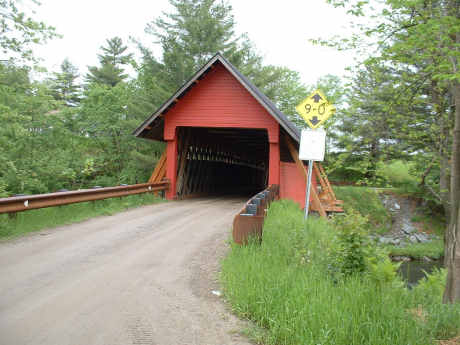 |
North Troy, Vt., June 6, 2008 The rehabilitation of North Troy's covered bridge, begun in July, 2007, has been completed, and has passed Final Inspection, says John Weaver, Vtrans Project manager.
The work was performed by low bidder Blow & Cote Construction of Morrisville, Vt. at a cost of $470,000.
The west abutment was stabilized and under-pinned with concrete and sheeting. The superstructure has added bracing (top chords and outside) to stabilize the bridge. Camber has been restored and the frame straightened. The bottom chords have new (replacement) wooden tension splices in numerous locations, and a new wooden deck (with protective curbs) has been installed within the supporting superstructure.
In addition, the bridge has been treated with fire retardant and insecticide, and new approach railings have been added.
VT-06-03
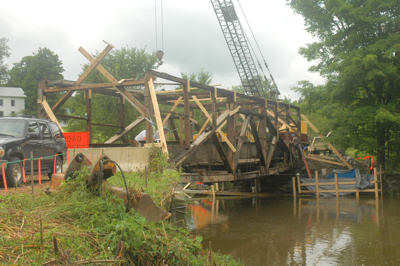 |
Photo by Joe Nelson, August 7, 2008 |
East Fairfield, August 7, 2008 - Work has begun on East Fairfield's Covered Bridge.
The project completion date is 6/26/2009. Blow and Cote's bid was $747,795, accepted on 6/23/08. The contractor has moved the bridge superstructure off its abutments, to perform rehabilitation of substructure and superstructure units He will then re-erect the trusses back on their foundations and perform finish work.
MA-08-04
The project's management and financing are controlled by the state Highway Department and the selectmen of Ware and Hardwick.
The Gilbertville Bridge, also known as the Ware-Hardwick Covered Bridge, was built in 1886 to cross the Ware River using a Town truss. The 137-foot span was renovated in 1986 and then closed in 2002 for traffic safety.
The project design plans are complete and the work will go out for bid in February, 2009. The cost is estimated to be $3.3 Million. Included in the cost are traffic signals and an electronic fire alarm system. The one-lane bridge will accommodate motor vehicles. Work is slated to be complete in September, 2009.
[Based on Springfield, MA Republican report forwarded by Tom Keating - Ed.]
IN-36-03
Brownstown, IN, August 21, 2008 - Jackson County is giving away the remains of the Bell's Ford covered bridge that collapsed into the East Fork White River to become a centerpiece in the Benjamin Harrison State Park in Indianapolis.
Located East of Cortland, Ind., the bridge's west span collapsed in 1999, the east span fell in 2006. The 330-foot, two-span bridge was built in 1869 using the Post Truss, half wood, half iron.
The reconstructed bridge will cross Fall Creek and connect an Indy Greenways trail from a city park to the state park. Signs noting the bridge's Jackson County history will be posted at both ends of the bridge, which will be used only by pedestrians and bicyclists.
The bridge will be restored during a two-year, $2 million effort. A coalition of preservationist groups is applying for a federal grant to help pay for the project.
[This item based on Chicagotribune.com report forwarded by Tom Keating - Ed.]
Ashtabula County, OH, August 21, 2008 - Ashtabula County's newest covered bridge, and the nation's longest, will be dedicated 2:30 p.m. August 26.
The bridge will be officially named at the ceremony. World Guide number 35-04-64 has already been assigned. The new bridge is 613 feet long and cost $8 million.
The bridge was designed by John Smolen, who was county engineer when the idea of bridging the Ashtabula River Gulf with a wooden structure was first conceived nearly a decade ago.
General contractor for the bridge is Union Industrial Contractors (UIC), which started work on it two years ago.
The usual ribbon cutting ceremony will be replaced by a log sawing, wherein officials will take turns with an old fashion cross-cut saw. The bridge will then be opened to pedestrian traffic, but closed to vehicular traffic pending road paving and the installation of guard rails.
[This item based on a Star Beacon; Ashtabula report forwarded by Tom Keating - Ed.]
NY State Office of Parks & Recreation News Release
"The Beaverkill Covered Bridge forms a centerpiece and focal point of the Catskill landscape and its listing on both the State and National Historic Registers will help provide additional recognition to this region as an historic, environmental and recreational resource," Commissioner Ash said. "The bridge continues to provide DEC's Beaverkill campground with a connection across this important river, and also symbolically connects both residents and visitors with the past."
The Beaverkill Covered Bridge was built in 1865 by John Davidson, a Scottish immigrant who was also involved in farming and lumbering, and it remains an important community connector. The bridge is a distinctive example of a Town lattice truss, a type of bridge construction favored for its considerable strength and ease of construction. The bridge was recommended for nomination by the New York State Board for Historic Preservation and placed on the New York State Register of Historic Places by Commissioner and State Historic Preservation Officer Carol Ash. It was subsequently nominated to and listed on the National Register of Historic Places.

July 21, 2008
Dear Steve:
Thanks to your announcement in the Summer 2008 "Bridger," I did visit the site of Bagley Bridge (on June 20th) at its new North Carolina location.
Completion is slated for November 2008. It spans a narrow, unnamed stream. The updated World Guide Number should be 33-56-01.
Howard Rogers, kkcodew@yahoo.com
[See Article "The Former Bagley Bridge . . . " in this issue - Ed.]
Hallo Joe
By Tom Keating I got an article with photo and scanty information about this new C.B. with a length of 613 feet the longest in the States. I appreciate your competent answer to the author John Horton. In "www.vermontbridges.com" I learned about the costs of $8 Million. The bridge must carry two lanes and must have an adequate bearing capacity. The costs seem to me rather high. 20 years ago a C.B. planned by our Road and Bridge Administration of one span just the length of one span of the Ashtabula bridge (153 feet) with two lanes and 40T bearing capacity. The costs were 60% higher than those of a similar concrete bridge built at the same time. The bridge deck (floor) is made of a homogeneous plate of glued-laminated timber with insulation on top of it, protected by asphalt pavement. This is the first guarantee for longevity (water transported into the bridge by wheels), the roof for the girders comes next.
Through your society I always get different kinds of valuable news as e.g. about "fighting graffiti". This is a big problem for our Swiss Capital Bern.
Yours in Bridging, Konrad Meyer-Usteri, Bolligen, Switzerland
Hi Konrad,
I am pleased that our website is useful to you. Feedback like yours make our efforts through the website and newsletter worthwhile. Thank you.
Yes, costs of timber bridge construction always does seem more expensive than that of concrete and steel. But time may tell us differently—the timber spans may very well significantly out last a similar concrete structure. We have had concrete and steel bridges in our Interstate System need replacing after only 30 years, mostly due to salt corrosion and materials fatigue
YIB, Joe Nelson
A Center for the Visual Arts*
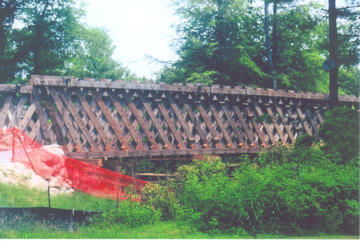 |
Photo by Howard Rogers, July2, 2008 |
A striking, rough-hewn 87-foot-5-inch long covered bridge serves as the welcoming entrance to The Bascom's six-acre campus in Highlands, North Carolina.
Dating from the early 1800s, the handcrafted wood structure began its existence as the Bagley covered bridge in Warner, New Hampshire, where it spanned the Warner River. The bridge was moved to Highlands in 2008. The reassembled bridge will be open and ready for one-way use in the spring of 2009 on The Bascom's new campus at U.S. 64 and Oak Street.
In the 1960s, the Bagley bridge was unfit for vehicular and pedestrian use. Warner, New Hampshire, authorities numbered the parts and disassembled it. Bridgewright and restoration conservationist Arnold M. Graton purchased the structure and put the parts into storage. In 2007, Franklin, North Carolina, native Wayne Yonce located the bridge and recommended it to The Bascom Board of Directors as a potential signature feature for their planned campus. The Bascom hired Arnold M. Graton Associates, Inc. of New Hampshire to move the Bagley bridge to Highlands and undertake the reconstruction of the structure for the art center's use.
The Bascom renamed the structure the Will Henry Stevens Covered Bridge in honor of the notable New Orleans artist and teacher. A pioneer of modernism in the American South, Will Henry Stevens (American, 1881-1949) was passionate not only about the bayous of coastal Louisiana, but also about the mountains of Western North Carolina, where he summered and painted. The Bascom owns his work, and selections will be on exhibition from time to time in its new facility.
The Will Henry Stevens Covered Bridge is a reconstruction by Arnold M. Graton featuring a lattice style that was patented by Ithiel Town in 1820 and 1835.
Graton's reconstruction process has been meticulous. He utilized centuries-old craft techniques and replaced rotten, insect-ridden or unstable parts. Rough-hewn parts were constructed out of white pine, oak, Douglas fir and other old~growth native species. Replacement wooden parts constitute about 60% of the bridge. No metal fasteners or screws, nuts or bolts are used in the bridge construction, only wood. Tree nails, trunnels or dowels—1,100 of them—join the wooden parts. Says Graton: "Wooden bridges far outlive the concrete ones, lasting 100 years or more as long as they stay high and dry."
The Bascom's bridge incorporates the distinctive Town's Lattice Truss style developed by architect Ithiel Town (American, 1784-1844). On January 28, 1820, Town was granted his first patent for this form of wooden truss bridge. The design had great importance because it could be built quickly by relatively unskilled workers from readily available material. The truss design also avoided the need for the wide piers needed for stone arches. The design was widely used throughout the United States and made Town wealthy. Town's truss design can still be seen in two of Connecticut's extant covered bridges, Bull's Bridge in Kent and West Cornwall Bridge in Cornwall and Sharon, and in New York's Eagleville Bridge and Shushan Bridge. Many other surviving covered bridges employ Town's design, including an "improved version" used in the construction of the Bunker Hill covered bridge in North Carolina.
Arnold M. Graton, bridgewright and restoration conservationist, works with vintage bridges and other wooden structures, e.g. barns, churches, mills and bridges. His goal is to preserve the past for our future. With The Bascom's Will Henry Stevens Bridge, Graton hopes for a lifespan of 300 years! For more information, see: http://arnoldmgraton.com.
Dave Fischetti, PE, of DCF Engineering, Inc., Cary, North Carolina, worked in tandem with Graton on the reconstruction of The Bascom's covered bridge. Fischetti is known for his work on nationally significant historic restoration and adaptive reuse projects, including the Bunker Hill covered bridge in Claremont, North Carolina, one of only two surviving original covered bridges in the state.
[*Edited from the Bascom Center for the Arts Fact Sheet forwarded by VCBS member Howard Rogers-Ed.]
 Return to First Page
Return to First Page





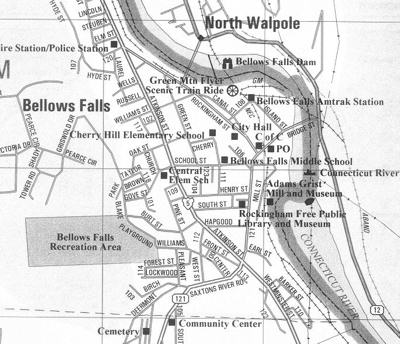

 Joe Nelson, P.O Box 267, Jericho, VT 05465-0267
This file posted 09/13/2008
Joe Nelson, P.O Box 267, Jericho, VT 05465-0267
This file posted 09/13/2008